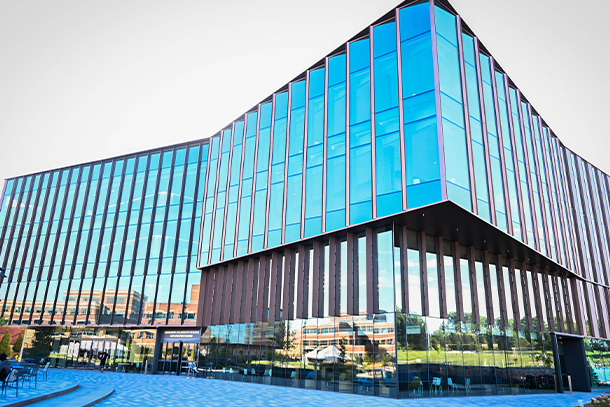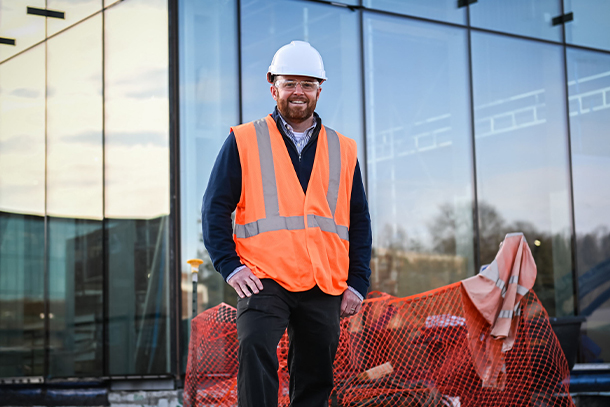
The newly constructed Engineering Collaborative Research and Education Building (ECoRE) is the largest academic building on any Penn State campus. Credit: Poornima Tomy/Penn State
New 'collaborative hub' showcases College of Engineering's West Campus expansion
Foundation of new Engineering Collaborative Research and Education Building forged in teamwork
September 12, 2024
By Tim Schley
UNIVERSITY PARK, Pa. — The roughly quarter-mile route between Hammond Building — the home base of the Penn State College of Engineering for 70 years — and the newly constructed Engineering Collaborative Research and Education (ECoRE) Building has been walked so many times by Craig Dubler, he wouldn’t be surprised to see faint rutted tracks already appearing under his feet in the freshly lain concrete.
He focuses on the destination, though, appreciating the hard work of hundreds while gazing upon the gleaming, triple-pane glass panels of the ECoRE atrium, the new face on the block of engineering buildings at Penn State University Park.
“We’ve constructed a legacy building,” said Dubler, the director of facilities for the College of Engineering, describing the ECoRE Building’s place in the college’s decade-long master plan to upgrade facilities and better share resources across campus. The plan created a new center of gravity for engineering-related activity and collaboration at Penn State on the west side of the University Park campus. Sitting across a grassy quad from the one-year old Engineering Design and Innovation Building, ECoRE and its assortment of research and teaching spaces, including nine general-purpose classrooms, flight simulators, wind tunnels, flumes and 3D projection systems, is its epicenter. The Board of Trustees approved final plans and construction of the building in 2021.

“I can’t wait to see what amazing things happen between these departments and others working together.”
— Craig Dubler, director of facilities for the College of EngineeringCredit: Poornima Tomy/Penn State
“It’s a showpiece, not just for what we engineer but how we work: collaboratively,” Dubler explained. ECoRE made neighbors of a former archipelago of academic departments, including aerospace engineering, architectural engineering, civil and environmental engineering and acoustics, bringing them closer to a host of other engineering-related departments already on West Campus. The building also houses the Engineering Library, and soon, the Center for Engineering Outreach and Inclusion and the Engineering Advising Center will move into it, too.
Dubler said he envisions a scenario where a civil engineer could enjoy a cup of coffee in the first-floor Knowledge Commons with an aerospace engineer and discuss anything from concrete to contrails as they find common ground, or air, in their work.
“I can’t wait to see what amazing things happen between these departments and others working together,” Dubler said. “The process of collaboration is on full display.”
Less visible to the public was the Herculean effort by many behind the shining façade to construct the 290,000 gross-square-foot facility, long before minds and machines began moving in and classes started being taught — although the exterior work was captured via livestream.
“It’s important to acknowledge the contributions of many individuals and teams who’ve worked across the past few years to make ECoRE a reality,” said Tonya L. Peeples, the Harold and Inge Marcus Dean of Engineering. “It promises to usher in an exciting next chapter for the College of Engineering as a dynamic home for teaching, learning, research, innovation and inspiration.”
The engineering facilities team worked closely with a variety of stakeholders, including the Penn State Office of the Physical Plant (OPP) — the “eyes and ears” on the project for Penn State, according to Dubler — the Whiting-Turner Contracting Company, the architecture firm Payette and more.
“The sheer scale of the building, coupled with the physical and mental endurance required for several years, has made this a career-defining experience for many, including the seasoned professionals,” said Brian Hayes, OPP facilities project manager for design and construction. “The end result is a testament not just to collaboration, but also to the spirit of cooperation that was critical for this project.”
The team of professionals constructed what Dubler called “a beautiful and efficient world-class facility.” A few of his favorite architectural features include the glass curtain wall and sawtooth façade with a copper finish; the natural light from the overhead skylight illuminating much of the building; and the “comfortable and clean” indoor air generated from the pipe-chilled beam HVAC system, powered by the University’s own utility services, managed by OPP.
He added that the building was declared ready for limited occupation in June — despite a nationwide labor shortage for construction workers.

“The team really came together and made it happen to let us occupy the building,” Dubler said, adding that it will come “full circle” when engineers in ECoRE help find solutions for challenges like the labor shortage. “Penn State engineers are going to solve the problem, and we’re going to do it collaboratively.”
Penn Staters at every stage
The allowance for occupancy in June began a cascading series of events to complete an intricate campus planning puzzle — what Dubler called “the final push.” The next phase of the college’s master facilities plan — the renovation of the historic Sackett Building, the demolition of the Engineering Units and, eventually, the demolition of Hammond Building — required a complex, coordinated transition plan for faculty, staff and student workers in those buildings to be relocated to ECoRE, much of this before the start of the fall semester.
“When planning, designing and constructing any project, it takes more than a village to create a world-class facility such as ECoRE,” said Michael Palotas, division vice president and national higher education leader for Whiting-Turner. “I can proudly say that transparency, open communication and trust were strong traits from all stakeholders. The faculty, staff and students are going to quickly learn this is a game-changing facility.”
Watch the excitement unfold as the ECoRE building is unveiled during the ribbon cutting ceremony.
Credit: Tyler Henderson/Penn State
Palotas, who graduated from Penn State in 2003 with a bachelor’s degree in mechanical engineering and a minor in engineering leadership and development, is one of an estimated 35 Penn State alumni who have contributed to the project.
“This building has made me consider coming back to get another engineering degree,” he said, pointing to the cutting-edge technology for research and teaching and the “carefully crafted” spaces for quiet study, group projects and overall collaboration.
Work continues on a small number of areas in the building, but many of the nearly 3,700 new chairs are now filled. Dubler’s regular walks through the building — he’s mulling over the potential for an indoor “ECoRE 5K” to take advantage of his total step count at this point — are ideal for collecting feedback from the new occupants and seeing how things are working, he said. Both Dubler and Hayes also make a concerted effort to regularly thank the workers for their hard work and coordination to get here.
“It was impressive to watch but also inspiring to talk to the construction workers who provided enthusiastic answers to my questions,” Hayes said. “I’m proud of all who diligently worked to turn the design into a physical reality.”

Members of the College of Engineering community thanked construction workers for their hard work as the building took shape. Credit: Poornima Tomy/Penn State


